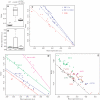Cell-to-cell stochastic variation in gene expression is a complex genetic trait
- PMID: 18404214
- PMCID: PMC2289839
- DOI: 10.1371/journal.pgen.1000049
Cell-to-cell stochastic variation in gene expression is a complex genetic trait
Abstract
The genetic control of common traits is rarely deterministic, with many genes contributing only to the chance of developing a given phenotype. This incomplete penetrance is poorly understood and is usually attributed to interactions between genes or interactions between genes and environmental conditions. Because many traits such as cancer can emerge from rare events happening in one or very few cells, we speculate an alternative and complementary possibility where some genotypes could facilitate these events by increasing stochastic cell-to-cell variations (or 'noise'). As a very first step towards investigating this possibility, we studied how natural genetic variation influences the level of noise in the expression of a single gene using the yeast S. cerevisiae as a model system. Reproducible differences in noise were observed between divergent genetic backgrounds. We found that noise was highly heritable and placed under a complex genetic control. Scanning the genome, we mapped three Quantitative Trait Loci (QTL) of noise, one locus being explained by an increase in noise when transcriptional elongation was impaired. Our results suggest that the level of stochasticity in particular molecular regulations may differ between multicellular individuals depending on their genotypic background. The complex genetic architecture of noise buffering couples genetic to non-genetic robustness and provides a molecular basis to the probabilistic nature of complex traits.
Conflict of interest statement
The authors have declared that no competing interests exist.
Figures




References
Publication types
MeSH terms
Substances
LinkOut - more resources
Full Text Sources
Other Literature Sources
Molecular Biology Databases
Research Materials

